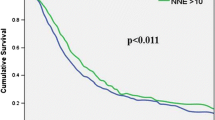Abstract
Background
The objective of this study was to compare the prognostic significance of the lymph node ratio (LNR) with the absolute number of affected lymph nodes for resected pancreatic ductal adenocarcinoma.
Methods
Data were collected from 84 patients who had undergone pancreatoduodenectomy for pancreatic ductal adenocarcinoma over a 10-year period. Patients were categorized into four groups according to the absolute LNR (0, 0–0.199, 0.2–0.299, ≥0.3). Kaplan-Meier and Cox proportional hazard models were used to evaluate the prognostic effect.
Results
An LNR of ≥0.2 (median survival 8.1 vs. 35.7 months with LNR < 0.2; p < 0.001) and ≥0.3 (median survival 5.9 vs. 29.6 months with LNR < 0.3; p < 0.001), tumor size (p < 0.017), positive resection margin (p < 0.001), and nodal involvement (p < 0.001) were found to be significant prognostic markers following univariate analysis. Following multivariate analysis, only LNR at both levels [≥0.2 (p = 0.05; HR 1.8) and LNR of ≥0.3 (p = 0.01; HR 2.7)] were independent predictors of a poor outcome. The number of lymph nodes examined had no effect on overall survival in either node-positive patients (p = 0.339) or node-negative patients (p = 0.473).
Conclusions
The LNR represents a stronger independent prognostic indicator than the absolute number of affected lymph nodes in patients with resected pancreatic ductal adenocarcinoma.




Similar content being viewed by others
References
James TA, Sheldon DG, Rajput A et al (2004) Risk factors associated with earlier age of onset in familial pancreatic carcinoma. Cancer 101:2722–2726
Alexakis N, Halloran C, Raraty M et al (2004) Current standards of surgery for pancreatic cancer. Br J Surg 91:1410–1427
Richter A, Niedergethmann M, Sturm JW et al (2003) Long-term results of partial pancreaticoduodenectomy for ductal adenocarcinoma of the pancreatic head: 25-year experience. World J Surg 27:324–329
Connor S, Bosonnet L, Ghaneh P et al (2004) Survival of patients with periampullary carcinoma is predicted by lymph node 8a but not by lymph node 16b1 status. Br J Surg 91:1592–1599
Sierzega M, Popiela T, Kulig J et al (2006) The ratio of metastatic/resected lymph nodes is an independent prognostic factor in patients with node-positive pancreatic head cancer. Pancreas 33:240–245
Berger AC, Watson JC, Ross EA et al (2004) The metastatic/examined lymph node ratio is an important prognostic factor after pancreaticoduodenectomy for pancreatic adenocarcinoma. Am Surg 70:235–240; discussion 240
Neoptolemos JP, Stocken DD, Dunn JA et al (2001) Influence of resection margins on survival for patients with pancreatic cancer treated by adjuvant chemoradiation and/or chemotherapy in the ESPAC-1 randomized controlled trial. Ann Surg 234:758–768
Winter JM, Cameron JL, Campbell KA et al (2006) 1423 Pancreaticoduodenectomies for pancreatic cancer: a single-institution experience. J Gastrointest Surg 10:1199–1210; discussion 1210–1211
Bassi C, Stocken DD, Olah A et al (2005) Influence of surgical resection and post-operative complications on survival following adjuvant treatment for pancreatic cancer in the ESPAC-1 randomized controlled trial. Dig Surg 22:353–363
Ueda M, Endo I, Nakashima M et al (2009) Prognostic factors after resection of pancreatic cancer. World J Surg 33:104–110
Kure S, Kaneko T, Takeda S et al (2005) Analysis of long-term survivors after surgical resection for invasive pancreatic cancer. HPB (Oxford) 7:129–134
Sohn TA, Yeo CJ, Cameron JL et al (2000) Resected adenocarcinoma of the pancreas-616 patients: results, outcomes, and prognostic indicators. J Gastrointest Surg 4:567–579
House MG, Gonen M, Jarnagin WR et al (2007) Prognostic significance of pathologic nodal status in patients with resected pancreatic cancer. J Gastrointest Surg 11:1549–1555
Pawlik TM, Gleisner AL, Cameron JL et al (2007) Prognostic relevance of lymph node ratio following pancreaticoduodenectomy for pancreatic cancer. Surgery 141:610–618
Tamandl D, Kaczirek K, Gruenberger B et al (2009) Lymph node ratio after curative surgery for intrahepatic cholangiocarcinoma. Br J Surg 96:919–925
Kulig J, Sierzega M, Kolodziejczyk P et al (2009) Ratio of metastatic to resected lymph nodes for prediction of survival in patients with inadequately staged gastric cancer. Br J Surg 96:910–918
Riediger H, Keck T, Wellner U et al (2009) The lymph node ratio is the strongest prognostic factor after resection of pancreatic cancer. J Gastrointest Surg 13:1337–1344
Brennan MF, Kattan MW, Klimstra D et al (2004) Prognostic nomogram for patients undergoing resection for adenocarcinoma of the pancreas. Ann Surg 240:293–298
Lim JE, Chien MW, Earle CC (2003) Prognostic factors following curative resection for pancreatic adenocarcinoma: a population-based, linked database analysis of 396 patients. Ann Surg 237:74–85
Breslin TM, Hess KR, Harbison DB et al (2001) Neoadjuvant chemoradiotherapy for adenocarcinoma of the pancreas: treatment variables and survival duration. Ann Surg Oncol 8:123–132
Bogoevski D, Onken F, Koenig A et al (2008) Is it time for a new TNM classification in esophageal carcinoma? Ann Surg 247:633–641
Sierra A, Regueira FM, Hernandez-Lizoain JL et al (2003) Role of the extended lymphadenectomy in gastric cancer surgery: experience in a single institution. Ann Surg Oncol 10:219–226
Rosenberg R, Friederichs J, Schuster T et al (2008) Prognosis of patients with colorectal cancer is associated with lymph node ratio: a single-center analysis of 3, 026 patients over a 25-year time period. Ann Surg 248:968–978
Acknowledgment
The authors appreciate the statistical guidance from Dr. Graham Warren, PhD, Department of Medical Statistics, University of Nottingham, UK.
Author information
Authors and Affiliations
Corresponding author
Rights and permissions
About this article
Cite this article
Bhatti, I., Peacock, O., Awan, A.K. et al. Lymph Node Ratio Versus Number of Affected Lymph Nodes as Predictors of Survival for Resected Pancreatic Adenocarcinoma. World J Surg 34, 768–775 (2010). https://doi.org/10.1007/s00268-009-0336-4
Published:
Issue Date:
DOI: https://doi.org/10.1007/s00268-009-0336-4




